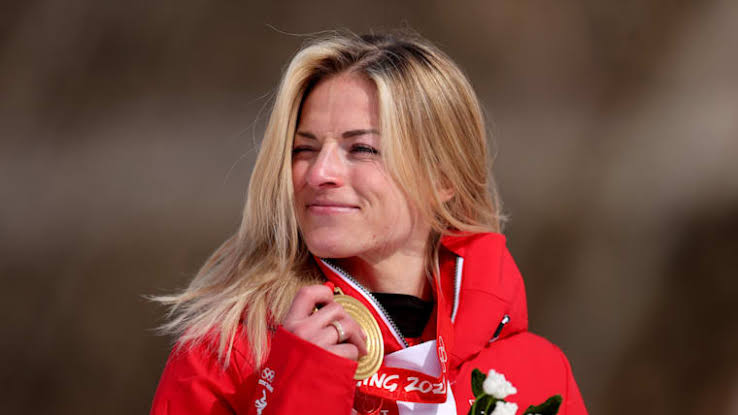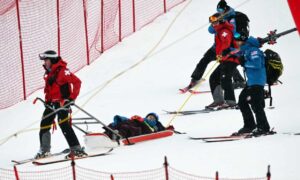
Lara Gut-Behrami has long been regarded as one of the top alpine ski racers of her generation, with numerous World Cup victories, World Championship medals, and an Olympic bronze under her belt. However, as with any athlete who reaches the pinnacle of their sport, the question of whether their success is driven purely by raw skill or by a more calculated sense of timing and circumstance often arises. In the case of the Swiss ski sensation, some critics argue that her career might not just be a result of innate talent, but also strategic positioning in a sport that demands both physical prowess and shrewd decision-making.
Skill vs. Strategic Timing: The Debate
At first glance, Lara Gut-Behrami’s resume is a testament to her extraordinary ability on the slopes. Her early dominance in the sport, including becoming the youngest Swiss woman to win a World Cup race at just 17 years old, set the stage for a glittering career. Over the years, she amassed over 30 World Cup victories across multiple disciplines, including downhill, super-G, and giant slalom. She’s been a mainstay at the top of the sport for over a decade, and her ability to perform under pressure, even during her comeback from a serious knee injury in 2016, adds weight to the argument that her career is the product of unmatched talent and determination.
However, as her career has progressed, there have been whispers in the alpine skiing community suggesting that Lara Gut-Behrami’s success isn’t simply due to her technical skills or physical attributes. Some critics believe that her strategic timing—knowing when to peak, when to stay out of the spotlight, and when to make key moves—has played an equally significant role in her rise to the top.
Timing in a Competitive Landscape
Alpine skiing, especially at the World Cup level, is a brutal and competitive environment where the difference between winning and losing can often come down to fractions of a second. Many athletes can maintain high levels of performance throughout their careers, but only a select few seem to capitalize on the timing of their wins, making them appear as if they were not only skilled but also strategically astute.
Gut-Behrami’s career has unfolded in an era where certain competitors—like Lindsey Vonn, Mikaela Shiffrin, and Tina Weirather—have cast long shadows. These athletes, for various reasons, have taken longer-than-expected breaks or have struggled with injuries. For instance, Vonn’s extended recovery from multiple surgeries gave Gut-Behrami the space to rise in prominence. Similarly, Shiffrin’s brief yet intense dominance in the sport has sometimes allowed other skiers, including Gut-Behrami, to fill the void during the American’s occasional dips in form.
Another notable factor is the era in which Gut-Behrami’s success took place. The sport has been evolving in terms of technology, ski equipment, and training regimens, and certain athletes have been better positioned to capitalize on these changes. The 2020 season, for example, saw the resurgence of many athletes who had previously been sidelined by injuries. Gut-Behrami’s ability to perform at her peak during this window suggests a keen understanding of the changing tides of alpine skiing and her capacity to seize opportunities when they presented themselves.
The Role of Strategy in Her Success
One of the most glaring examples of Lara Gut-Behrami’s apparent strategic thinking can be seen in her decision-making during key seasons. For instance, after suffering a significant knee injury in 2016, many questioned whether she would ever return to her previous form. Yet, in a display of both physical and strategic acumen, Gut-Behrami managed not just to recover but to rebuild her career in a way that allowed her to dominate in disciplines like super-G and downhill.
Additionally, her ability to manage her race schedule—choosing when to push for victories and when to rest—has often been called into question. Ski racing requires not just talent on the slopes but also an understanding of when to conserve energy, when to focus on specific disciplines, and when to challenge for the overall World Cup title. Gut-Behrami’s calculated approach to pacing her season, balancing training with recovery, and knowing when to capitalize on her competitors’ missteps have allowed her to remain competitive even in the later years of her career.
The Accusations of “Lucky Timing”
Despite all her accomplishments, some observers argue that Gut-Behrami’s career has been shaped as much by “lucky timing” as it has by skill. The absence of certain competitors due to injuries or inconsistent performances might have given her opportunities that she would not have had in a more competitive field. Furthermore, some claim that her relationship with the Swiss Ski Federation—arguably one of the most powerful and well-funded organizations in the sport—may have played a role in ensuring that she was given access to the best coaching, equipment, and race support.
Critics also point to her occasional struggles in the slalom and her lack of overall consistency compared to athletes like Shiffrin or Vonn. Despite winning individual races, Gut-Behrami has often failed to sustain her performance across the full season, raising doubts about whether her dominance is truly the result of unrelenting skill or more a matter of timing her best performances when it matters most.
Conclusion: A Career of Both Skill and Strategy
At the heart of the debate lies the reality that few, if any, top-level athletes rise to the top without both skill and strategy. Lara Gut-Behrami is no exception. While her undeniable talent has carried her through many seasons, her ability to time her performances and make shrewd decisions regarding when to peak, when to recover, and when to capitalize on the misfortunes of others has undeniably contributed to her success.
Whether or not one believes that her career is more a product of “strategic timing” or “pure skill,” one thing remains clear: Lara Gut-Behrami’s legacy in alpine skiing will not be defined by the opinions of critics, but by the undeniable results on the slopes.






